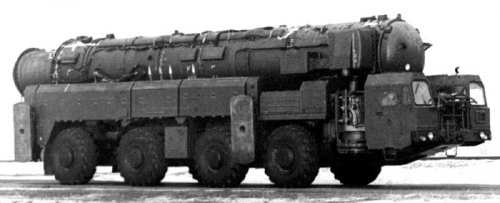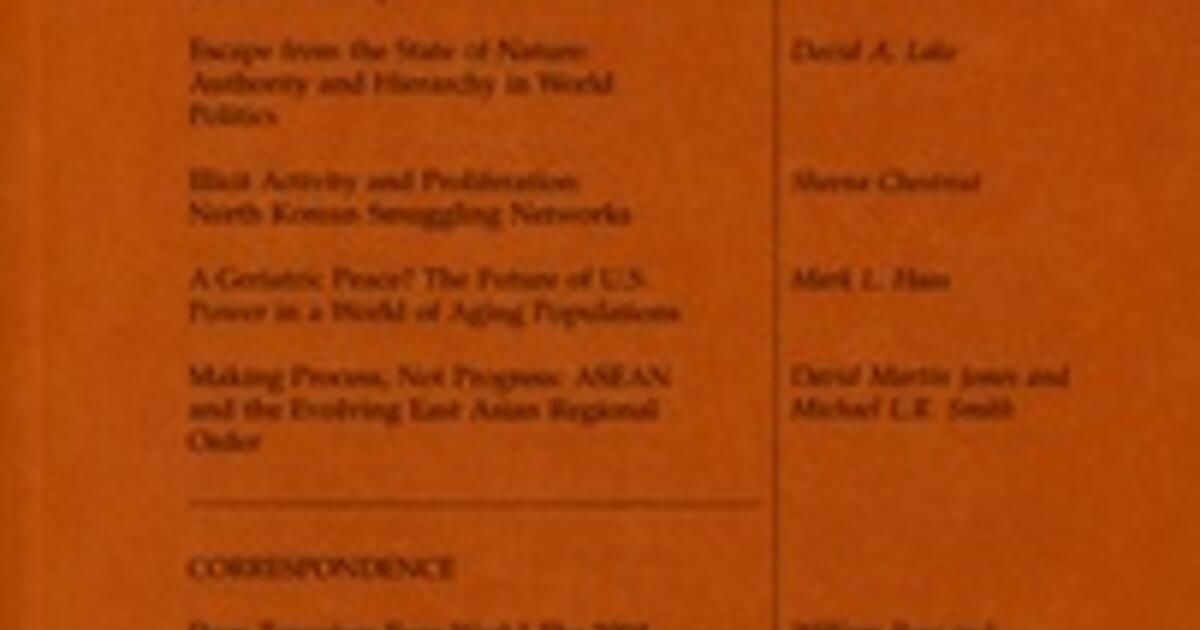Soviet Ballistic Missile Projects of the 1980s
Return to Index
Koltso
Years: 1976-?
Designer: Yuzhnoye
Lenght:
Diameter:
Launch Weight:
Warhead: Nuclear
Propulsion:
Guidance: Inertial
Maximum Range:
CEP:
The Koltso advanced ICBM was ordered from Yuzhnoye on 29 September 1976. Development was authorised on 31 May 1984 but the project was later cancelled.
Kurier
Years: 1981-1991
Bilateral Designation: RSS-40
DoD Designation: SS-X-26
Designer: MITT
Lenght:
Diameter:
Launch Weight: 15,000 kg
Warhead: 500 kg nuclear
Propulsion: Three-stage solid-propellant rocket
Guidance: Inertial
Maximum Range: 11,000 km
CEP:
Launch Vehicle
Designation: MAZ-7909/MAZ-7929
Weight: ?/60,000 kg
Load Capacity: 27,500/35,000 kg
Engine: YaMZ-8424.10 420 hp diesel
Crew: 3/3
The development of the Kurier small ICBM began at MITT in 1981 under the management of A.D. Nadiradze, replaced in 1987 by B.N. Lagutin. The draft design was finalized in 1984, and the system was approved for development. According to some sources the missile was first tested in 1986, whereas other sources claim that major system components were tested separately, and flight tests were to begin 1992. In any case the program was cancelled on 6 October 1991. The missile was launched from its launch container with a solid-propellant gas generator. The prototype of the MAZ-7909 8x8 wheeled chassis was built in 1987, and that of the MAZ-7929 10x8 wheeled chassis in 1988.
Kopye-R
Years: 1985-1986
Designer: Yuzhnoye
Lenght:
Diameter:
Launch Weight:
Warhead: Nuclear
Propulsion: Three-stage liquid-propellant rocket
Guidance: Inertial
Maximum Range:
CEP:
The Kopye-R was designed by Yuzhnoye since July 1985 as a liquid-propellant alternative to the Kurier small ICBM. The draft project was completed in February 1986, but the Kurier was selected for further development.
Krechet-R
Years: 1983-1984
Designer: Yuzhnoye
Lenght: 10.7 m
Diameter: 1.6 m
Launch Weight: 24,400 kg
Warhead: 1,400 kg nuclear/six nuclear MIRVs
Propulsion: Two-stage solid-propellant rocket
Guidance: Inertial
Maximum Range: 7,500 km
CEP: 600 m
Work on the Krechet scientific research program for an air-based missile system began in July 1983 with V.F. Utkin of Yuzhnoye design bureau as chief designer. The primary aim of the project was to increase the survivability of nuclear counter-strike forces. The Krechet-R ALBM was a two-stage solid-propellant fourth generation missile with a liquid-propellant warhead bus. First stage was controlled by aerodynamic surfaces, and the second stage by a rotating nozzle. The warhead section contained penetration aids. It was proposed to use a Tupolev Tu-160 variant with an increased load capacity of 50 tons designated Tu-160K as the launch platform. Two missiles were to be carried in the bomb bays of the aircraft. Ground support equipment for the missile was designed by KBTM. Draft design of the system was completed in December 1984, but development was not proceeded with.
Skorost
Years: 1982-1987
Designer: MITT
Lenght:
Diameter:
Launch Weight:
Warhead: Single/three nuclear or conventional
Propulsion: Two-stage solid-propellant rocket
Guidance: Inertial
Maximum Range: 4,000 km
CEP:
Launch Vehicle
Designation: MAZ-7908
Weight: 60,000 kg
Load Capacity: 36,000 kg
Engine: V-58-7 710 hp diesel
Crew: 3
The development of the Skorost IRBM began at MITT in 1982 under the management of A.D. Nadiradze, and design work was completed in 1986. The first test launch on 1 March 1987 from Kapustin Yar ended in a failure when the first stage nozzle burned through and the missile had to be self-destroyed. No further tests were conducted, as the program was cancelled on 7 March 1987 due to the imminent INF treaty. A total of 10 missiles had been constructed. The Skorost was intended as an inexpensive theater strike weapon for both the Strategic Rocket Troops and the Army in the European theater. It was possibly made of the second and third stages of the RT-2PM (SS-25) ICBM. The guidance system was designed by Pilyugin.
Albatros
Years: 1987-1991
Designer: Mashinnostrenya
Lenght:
Diameter:
Launch Weight:
Warhead: Nuclear
Propulsion: Three-stage solid-propellant rocket
Guidance: Inertial
Maximum Range:
CEP:
The development of the Albatros ICBM was authorized on 9 February 1987. Chief designer was Gerbert Yefremov. Together with the Yuzhnoye RT-2PM2 Universal it was to be a cheap mass-produceable missile to defeat the American SDI system by sheer numbers.
RT-2PM2 Universal
Years: 1987-1991
DoD Designation: SS-X-27
Designer: Yuzhnoye
Lenght: 22.71 m
Diameter: 1.86 m
Launch Weight: 47,000 kg
Warhead: 1,200 kg nuclear
Propulsion: Three-stage solid-propellant rocket
Guidance: Inertial
Maximum Range: 10,500 km
CEP: 350 m
Work on the RT-2PM2 ICBM based on the RT-2PM Topol began in the late 1980s. The first missile was delivered to the Plesetsk test range on 30 December 1991, but the project was cancelled on the breakup of the Soviet Union. Two missiles had been completed, and they were handed over to MITT in March-April 1992, where they were used as a basis for the Russian Topol-M missile. Like the NPO Mashinnostrenya Albatros, the RT-2PM2 was to be an inexpensive mass-produceable missile to defeat the American SDI system by sheer numbers and deployable in both silo and road-mobile versions.
RT-23M Yarmak
Years: 1990-1991
Designer: Yuzhnoye
Lenght:
Diameter:
Launch Weight:
Warhead: Ten nuclear MIRV
Propulsion: Three-stage solid-propellant rocket
Guidance: Inertial
Maximum Range: 11,000 km
CEP:
The RT-23M Yarmak was an improved development of the RT-23 (SS-24) ICBM.
R-36M3 Ikar
Years: 1990-1991
Designer: Yuzhnoye
Lenght:
Diameter:
Launch Weight:
Warhead: Ten nuclear MIRV
Propulsion: Two-stage solid-propellant rocket
Guidance: Inertial
Maximum Range: 16,000 km
CEP:
The R-36M3 Ikar was designed as a next-generation replacement for the R-36M2 (SS-18 Mod 5/6) ICBM. Work on the missile began in the early 1990s under the management of Stanislav Us. Unlike previous R-36M versions, the missile was to use solid propellants, and also nested rocket stages.
Main sources:
True Supersonics
Encyclopedia Astronautica
Russian Space Web
Return to Index


